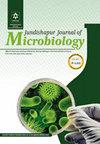短期膜基培养结合双靶融合分析快速分化常见念珠菌的研究进展
IF 0.5
4区 医学
Q4 MICROBIOLOGY
引用次数: 0
摘要
背景:念珠菌是严重粘膜和侵袭性念珠菌病的主要病原体。不同种类的念珠菌对抗真菌治疗表现出不同程度的耐药性。据估计,抗真菌治疗每延迟12小时,患者死亡率和治疗费用就会显著增加。培养法被认为是鉴定念珠菌种类的金标准,但其耗时的过程是一个明显的缺点。目的:建立膜技术结合双靶熔融分析快速培养和鉴定常见念珠菌的方法。该方法有望保留传统培养方法的优点并改进其缺点,同时也评估该方法的实际应用。方法:采用微滤膜培养-示色法快速培养念珠菌。以5.8S核糖体DNA区和内部转录间隔区(ITS2)区为靶基因区,采用两组引物。采用双目标实时聚合酶链反应(PCR)进行熔解分析,以区分白色念珠菌、热带念珠菌、光滑念珠菌和克鲁塞念珠菌。为评价该方法的实际应用价值,对72株临床分离株进行了试验,并与显色培养法和DNA测序法进行了比较。结果:在四种常见念珠菌中检测到两个基因靶点的不同融化温度。从培养到鉴定的整个过程在12小时内完成,比金标准法缩短了约50%的时间。念珠菌的最低检出限为10飞图。临床分离株鉴定结果与DNA测序结果一致。结论:短期膜培养结合双靶点熔融分析可快速、简便、准确地鉴定常见念珠菌种类,从而缩短重症念珠菌病患者启动靶向治疗的时间。本文章由计算机程序翻译,如有差异,请以英文原文为准。
Development of Short-term Membrane-based Cultivation Combined with Dual-target Melting Analysis for Rapid Differentiation of Common Candida Species
Background: Candida is the main causative agent of severe mucosal and invasive candidiasis. Different species of Candida have shown varying levels of resistance to antifungal treatments. It is estimated that each 12-hour delay in antifungal treatment is associated with a significant increase in patient mortality and treatment costs. The culture method is regarded as the gold standard for identifying Candida species, but its time-consuming process is a clear disadvantage. Objectives: This study established a method using membrane technology combined with dual-target melting analysis for rapid cultivation and identification of common Candida species. This method is expected to preserve the advantages of the conventional culture method and improve upon its weaknesses while also evaluating the practical application of the method. Methods: A microfiltration membrane-based culture followed by a color indicator method was established to rapidly cultivate Candida cultures. The 5.8S ribosomal DNA region and internal transcribed spacer 2 (ITS2) region were used as target gene regions, for which two sets of primers were employed. Melting analysis following dual-target real-time polymerase chain reaction (PCR) was conducted to distinguish among Candida albicans, C. tropicalis, C. glabrata, and C. krusei. To evaluate its practical application, the method was tested with 72 clinical isolates, and the results were compared with those obtained using the chromogenic culture method and DNA sequencing. Results: Distinctive melting temperatures in the two gene targets were detected among the four common Candida species. The entire process, from cultivation to identification, was completed within 12 hours, about 50% less time than the gold-standard method. The minimum detection limit of Candida species was 10 femtograms. The results of the identification of the clinical isolates were consistent with those of DNA sequencing. Conclusions: The short-term membrane-based cultivation combined with dual-target melting analysis can be used to rapidly, easily, and accurately identify common Candida species, thus reducing the time needed to initiate targeted treatment for patients with severe candidiasis.
求助全文
通过发布文献求助,成功后即可免费获取论文全文。
去求助
来源期刊

Jundishapur Journal of Microbiology
MICROBIOLOGY-
CiteScore
1.30
自引率
0.00%
发文量
56
审稿时长
6-12 weeks
期刊介绍:
Jundishapur Journal of Microbiology, (JJM) is the official scientific Monthly publication of Ahvaz Jundishapur University of Medical Sciences. JJM is dedicated to the publication of manuscripts on topics concerning all aspects of microbiology. The topics include medical, veterinary and environmental microbiology, molecular investigations and infectious diseases. Aspects of immunology and epidemiology of infectious diseases are also considered.
 求助内容:
求助内容: 应助结果提醒方式:
应助结果提醒方式:


